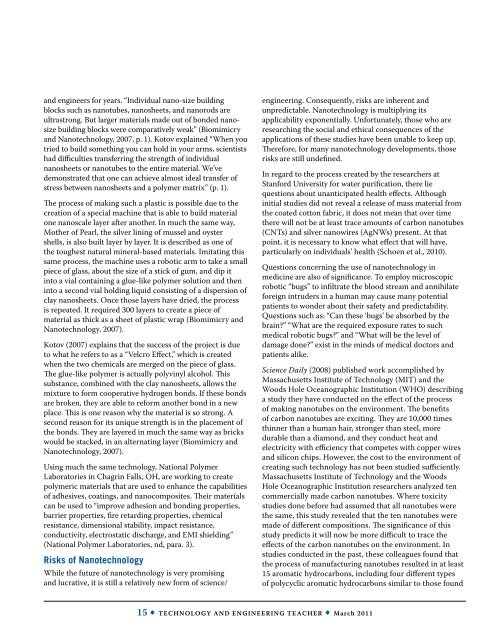March - Vol 70, No 6 - International Technology and Engineering ...
March - Vol 70, No 6 - International Technology and Engineering ...
March - Vol 70, No 6 - International Technology and Engineering ...
You also want an ePaper? Increase the reach of your titles
YUMPU automatically turns print PDFs into web optimized ePapers that Google loves.
<strong>and</strong> engineers for years. “Individual nano-size building<br />
blocks such as nanotubes, nanosheets, <strong>and</strong> nanorods are<br />
ultrastrong. But larger materials made out of bonded nanosize<br />
building blocks were comparatively weak” (Biomimicry<br />
<strong>and</strong> Nanotechnology, 2007, p. 1). Kotov explained “When you<br />
tried to build something you can hold in your arms, scientists<br />
had difficulties transferring the strength of individual<br />
nanosheets or nanotubes to the entire material. We’ve<br />
demonstrated that one can achieve almost ideal transfer of<br />
stress between nanosheets <strong>and</strong> a polymer matrix” (p. 1).<br />
The process of making such a plastic is possible due to the<br />
creation of a special machine that is able to build material<br />
one nanoscale layer after another. In much the same way,<br />
Mother of Pearl, the silver lining of mussel <strong>and</strong> oyster<br />
shells, is also built layer by layer. It is described as one of<br />
the toughest natural mineral-based materials. Imitating this<br />
same process, the machine uses a robotic arm to take a small<br />
piece of glass, about the size of a stick of gum, <strong>and</strong> dip it<br />
into a vial containing a glue-like polymer solution <strong>and</strong> then<br />
into a second vial holding liquid consisting of a dispersion of<br />
clay nanosheets. Once those layers have dried, the process<br />
is repeated. It required 300 layers to create a piece of<br />
material as thick as a sheet of plastic wrap (Biomimicry <strong>and</strong><br />
Nanotechnology, 2007).<br />
Kotov (2007) explains that the success of the project is due<br />
to what he refers to as a “Velcro Effect,” which is created<br />
when the two chemicals are merged on the piece of glass.<br />
The glue-like polymer is actually polyvinyl alcohol. This<br />
substance, combined with the clay nanosheets, allows the<br />
mixture to form cooperative hydrogen bonds. If these bonds<br />
are broken, they are able to reform another bond in a new<br />
place. This is one reason why the material is so strong. A<br />
second reason for its unique strength is in the placement of<br />
the bonds. They are layered in much the same way as bricks<br />
would be stacked, in an alternating layer (Biomimicry <strong>and</strong><br />
Nanotechnology, 2007).<br />
Using much the same technology, National Polymer<br />
Laboratories in Chagrin Falls, OH, are working to create<br />
polymeric materials that are used to enhance the capabilities<br />
of adhesives, coatings, <strong>and</strong> nanocomposites. Their materials<br />
can be used to “improve adhesion <strong>and</strong> bonding properties,<br />
barrier properties, fire retarding properties, chemical<br />
resistance, dimensional stability, impact resistance,<br />
conductivity, electrostatic discharge, <strong>and</strong> EMI shielding”<br />
(National Polymer Laboratories, nd, para. 3).<br />
Risks of Nanotechnology<br />
While the future of nanotechnology is very promising<br />
<strong>and</strong> lucrative, it is still a relatively new form of science/<br />
engineering. Consequently, risks are inherent <strong>and</strong><br />
unpredictable. Nanotechnology is multiplying its<br />
applicability exponentially. Unfortunately, those who are<br />
researching the social <strong>and</strong> ethical consequences of the<br />
applications of these studies have been unable to keep up.<br />
Therefore, for many nanotechnology developments, those<br />
risks are still undefined.<br />
In regard to the process created by the researchers at<br />
Stanford University for water purification, there lie<br />
questions about unanticipated health effects. Although<br />
initial studies did not reveal a release of mass material from<br />
the coated cotton fabric, it does not mean that over time<br />
there will not be at least trace amounts of carbon nanotubes<br />
(CNTs) <strong>and</strong> silver nanowires (AgNWs) present. At that<br />
point, it is necessary to know what effect that will have,<br />
particularly on individuals’ health (Schoen et al., 2010).<br />
Questions concerning the use of nanotechnology in<br />
medicine are also of significance. To employ microscopic<br />
robotic “bugs” to infiltrate the blood stream <strong>and</strong> annihilate<br />
foreign intruders in a human may cause many potential<br />
patients to wonder about their safety <strong>and</strong> predictability.<br />
Questions such as: “Can these ‘bugs’ be absorbed by the<br />
brain?” “What are the required exposure rates to such<br />
medical robotic bugs?” <strong>and</strong> “What will be the level of<br />
damage done?” exist in the minds of medical doctors <strong>and</strong><br />
patients alike.<br />
Science Daily (2008) published work accomplished by<br />
Massachusetts Institute of <strong>Technology</strong> (MIT) <strong>and</strong> the<br />
Woods Hole Oceanographic Institution (WHO) describing<br />
a study they have conducted on the effect of the process<br />
of making nanotubes on the environment. The benefits<br />
of carbon nanotubes are exciting. They are 10,000 times<br />
thinner than a human hair, stronger than steel, more<br />
durable than a diamond, <strong>and</strong> they conduct heat <strong>and</strong><br />
electricity with efficiency that competes with copper wires<br />
<strong>and</strong> silicon chips. However, the cost to the environment of<br />
creating such technology has not been studied sufficiently.<br />
Massachusetts Institute of <strong>Technology</strong> <strong>and</strong> the Woods<br />
Hole Oceanographic Institution researchers analyzed ten<br />
commercially made carbon nanotubes. Where toxicity<br />
studies done before had assumed that all nanotubes were<br />
the same, this study revealed that the ten nanotubes were<br />
made of different compositions. The significance of this<br />
study predicts it will now be more difficult to trace the<br />
effects of the carbon nanotubes on the environment. In<br />
studies conducted in the past, these colleagues found that<br />
the process of manufacturing nanotubes resulted in at least<br />
15 aromatic hydrocarbons, including four different types<br />
of polycyclic aromatic hydrocarbons similar to those found<br />
15 • <strong>Technology</strong> <strong>and</strong> <strong>Engineering</strong> Teacher • <strong>March</strong> 2011
















